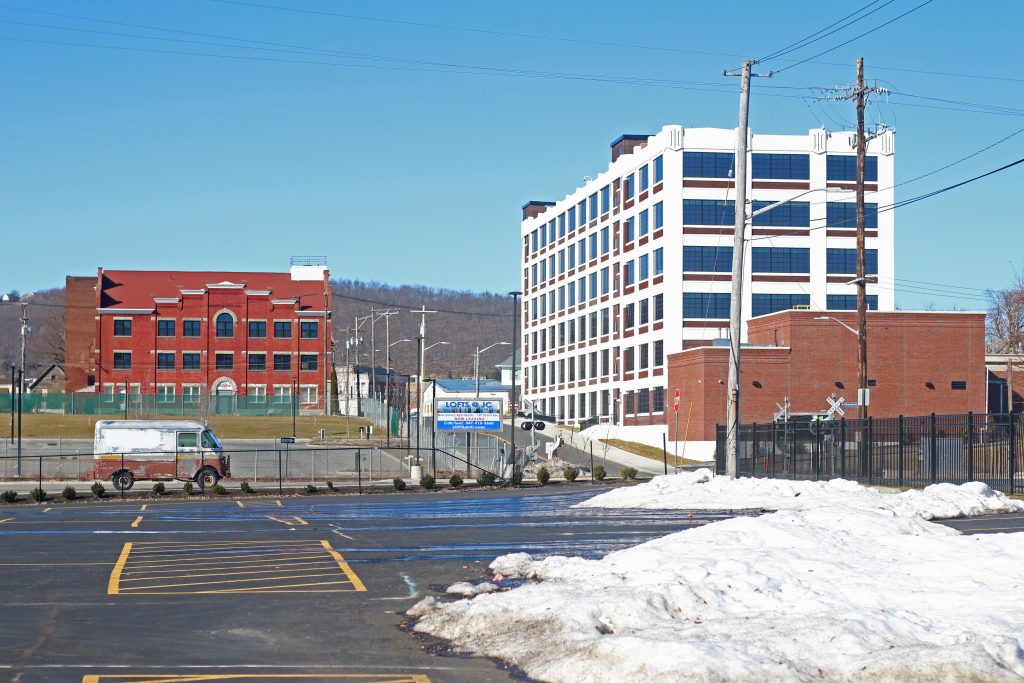Binghamton University is working with the local Johnson City government to develop a park near the health sciences campus.
On March 26, BU President Harvey Stenger announced over WNBF News Radio 1290 that the University is creating a greenspace within the BU Health Sciences Campus in Johnson City. Near the recently built campus for the Decker College of Nursing and Health Sciences, the two-acre project will contain a park and a walkway between Corliss Avenue and Main Street with amenities, such as art installations, picnic tables and benches. The project will be exclusively funded through the Binghamton University Foundation, although designs of the park are being collaborated on by the University, Broome County and the Johnson City Mayor’s Office. Construction is planned to start by the end of April.
The greenspace is another part of the recent Downtown Johnson City revitalization in the areas surrounding the BU Health Sciences Campus, which includes the development of new apartment complexes Century Sunrise Residences, located on Baldwin Street, and LOFTS@JC, located on Grand Avenue. The BU Health Science Campus itself was renovated from the abandoned Endicott-Johnson Shoe Company factory and opened its doors to students this semester. For the construction of the greenspace, several buildings along Lewis Street, Jennison Avenue, Willow Street and Main Street will be demolished.
The construction of the greenspace and the entire BU Health Science Campus has drawn criticism, including the issue of a lack of transparency for revitalization plans with local officials. Angela Riley, council member representing the third district on the Binghamton City Council, was not informed about the construction of the new greenspace. Riley is also a member of the Town-Gown Advisory Board (TGAB), a committee between BU and community members that address the University and student impact on local neighborhoods.
Johnson City Mayor Greg Deemie believes the new greenspace and the overall construction of the BU Health Science Campus will promote economic growth and improve the lives of residents rather than hurting them.
“The influx of students, faculty and staff will create a boost of life to the area,” Deemie wrote in an email. “It will create new opportunities for jobs and businesses. It has added new housing for low- to moderate-income families. With the removal of the blighted structures and addition of the park, the area will have cleaner surroundings. I believe it will better the lives of those in the community.”
Ryan Yarosh, senior director of media and public relations at BU, concurred with Deemie, pointing out that projects, specifically the Century Sunrise Residences apartment complex, have promoted housing affordability rather than deterring it.
“This apartment complex increased affordable housing by 105 apartments,” Yarosh wrote in an email. “The $33 million mixed purpose building offers affordable apartments to individuals and families at multiple income levels. The building also has 9,000 square feet of commercial space on the ground floor. The complex included apartments set aside for individuals with intellectual and developmental disabilities. The revitalization of these two significant buildings is vital to the core of Johnson City.”
According to Yarosh, students expressed interest in a park via University surveys on how to improve the BU Health Sciences Campus. He said the Johnson City Redevelopment Project, led by John Frazier, director of graduate studies and SUNY distinguished professor in geography, looked into the possible effects of such a project and judged how it should be done to maximize benefits for both students and local residents.
“His research team consists of faculty and graduate students under faculty supervision who know what type of data collection is necessary around neighborhood revitalization,” Yarosh wrote. “This project monitors neighborhoods around the [BU] Health Sciences Campus to detect any critical changes to businesses, residents, community services and other stakeholders in this community.”
The research team tracks changes in demographics, housing, infrastructure, crime and the local businesses in the surrounding BU Health Sciences Campus area and publishes them onto their website. The website also provides an interactive map called Story Map, which allows users to interact and be informed about demographic and economic changes in the revitalized area.
Emily Guida, a senior majoring in nursing, said she believes the greenspace will provide an area that students can unwind from their rigorous coursework.
“I think creating a greenspace is a great idea,” Guida said. “It would be so nice if, after a long day of studying or simulation, students could walk around the park or sit and read a book to de-stress. Whenever the sun comes out here and it is warm, students love to be outside. Providing more space and opportunity to do so could really benefit everyone.”
The website to the Johnson City Revitalization Project and Story Map can be found here.



